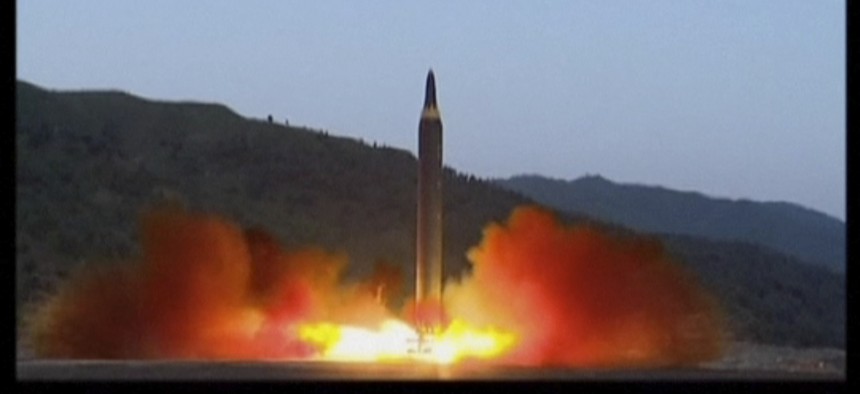
This image made from video of a news bulletin aired by North Korea's KRT on Monday, May 15, 2017, shows what was said to be the launch of the Hwasong-12 missile at an undisclosed location in North Korea. KRT via AP Video
Kim Jong Un Plans to Mass Produce Ballistic Missiles
After a successful test launch on Sunday, the North Korean leader approved the deployment of medium-range ballistic missiles.
Following the launch of a medium-range ballistic missile on Sunday, North Korean leader Kim Jong Un called for the missile’s mass production and eventual deployment, the nation’s Korean Central News Agency (KCNA) reported Monday. According to the news outlet, Kim approved the missile “for action” after praising its accuracy, saying it should be “rapidly mass produced in a serial way.”
Despite receiving a satisfactory response from Kim, Sunday’s launch was not the most successful to date. On May 14, North Korea launched a new type of intermediate-range missile called Hwasong-12, which is capable of carrying a large nuclear warhead. The missile went further and flew higher than any previous launch, reaching a distance of 430 miles and an altitude of more than 1,245 miles. By contrast, South Korean officials reported that Sunday’s missile flew 310 miles and reached an altitude of 348 miles. While Hwasong-12 relies on liquid fuel and was launched from the ground, Sunday’s missile, known as Pukguksong-2, relies on solid fuel and was launched from a mobile vehicle. This allows it to be pre-loaded with fuel and moved to a launch site, cutting down on the time it takes to fire an attack.
Sunday’s test launch aimed to see how the missile would fare under battle conditions. North Korea is known to be developing an intercontinental ballistic missile (IBCM) capable of reaching U.S. bases in South Korea, Japan, and Guam. In August, KCNA quoted Kim as saying that the U.S. mainland and its “operational theater in the Pacific” are within “striking range.” In February, a North Korean ambassador told the United Nations that the missile tests are “self-defense measures to protect national sovereignty and the safety of [North Koreans] against direct threats by hostile forces.”
In order for a North Korean missile launch to reach the U.S. mainland, its nuclear warhead must be able to withstand re-entry into the earth’s atmosphere. Officials say this technology could be years away, though many failed to anticipate North Korea’s progress in recent months. In the wake of Sunday’s test launch, North Korea’s state media published a collection of photographs reportedly taken from a camera on board the missile. According to North Korea, the images will help scientists improve the position and steering functions of a nuclear warhead.
On Monday, Michael Elleman, a senior fellow for missile defense at the International Institute for Strategic Studies, told NBC News that North Korea’s claims have to be taken “with a grain of salt,” since the nation “tend[s] to deploy things before they’re really ready.” David Wright, the co-director of the Global Security Program at the the Union of Concerned Scientists, echoed this statement in a blog post. According to Wright, North Korea is “still in [the] early stages” of its missile development:
If you look at examples of other countries building long-range solid missiles, such as France and China, it took them several decades to get from the point of building a medium-range solid missile, which North Korea has done, to building a solid ICBM. So this is not something that will happen soon, but with time North Korea will be able to do it.
In a statement to USA TODAY, Wright also provided an explanation for North Korea’s urgency when it comes to missile testing. With the UN threatening to increase sanctions on North Korea, Wright argued, Kim could finally be prepared to comply with UN Security Council resolutions. According to USA TODAY, “Wright said he thinks Kim is ready to make a deal, and the rush of tests in recent weeks is probably the North’s effort to ‘make what progress they can before they freeze things.’” On Tuesday, the Security Council is scheduled to convene again to discuss North Korea’s missile testing following a request from Japan, South Korea, and the U.S.